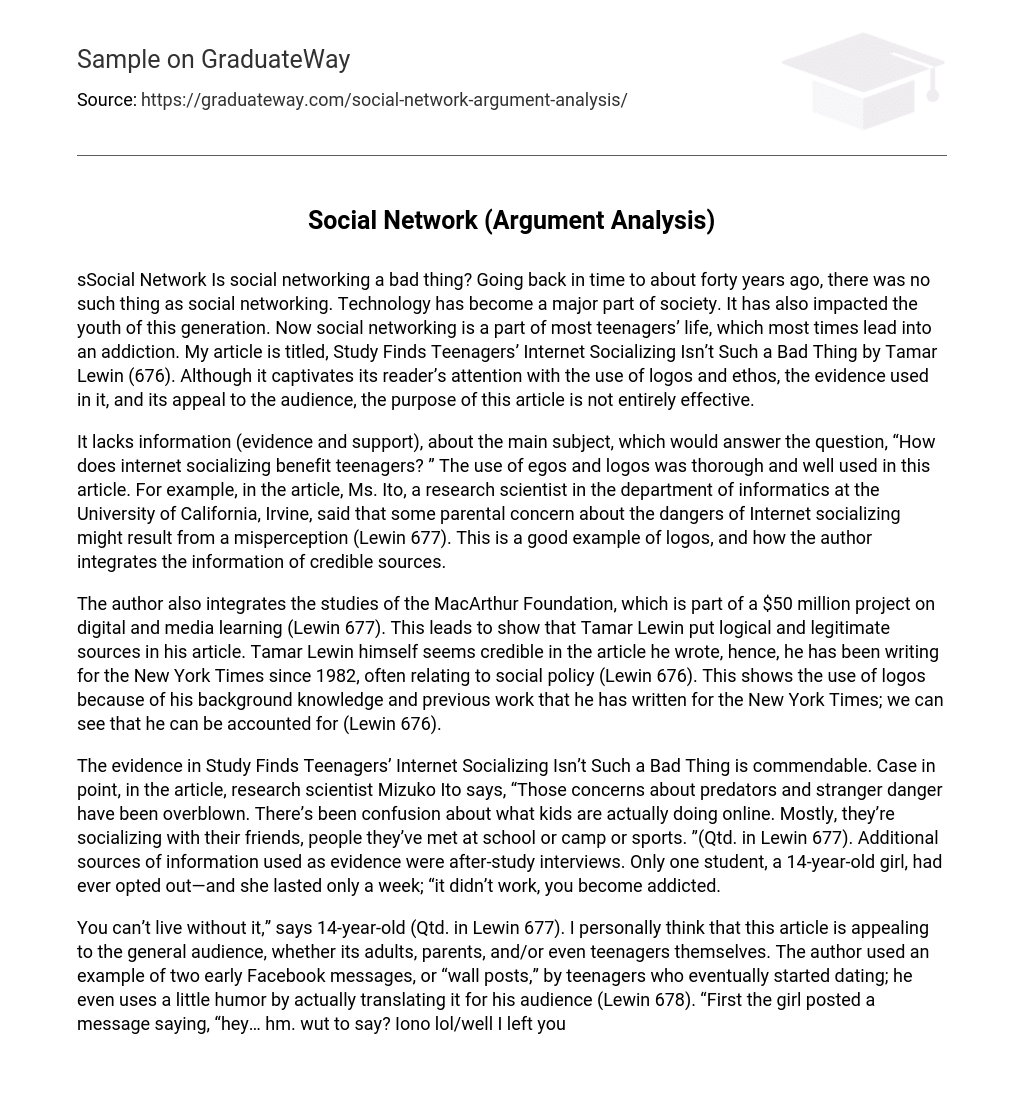Is social networking a bad thing? Technology has become a major part of society, impacting the youth of this generation. Social networking is now a part of most teenagers’ lives and often leads to addiction. The article titled “Study Finds Teenagers’ Internet Socializing Isn’t Such a Bad Thing” by Tamar Lewin discusses the effects of social networking on teenagers. While the article uses logos and ethos to captivate readers, presents evidence, and appeals to the audience, its purpose is not entirely effective.
The article lacks supporting information about the benefits of internet socializing for teenagers. The author effectively uses ethos and logos to back up their points. For instance, Ms. Ito, a research scientist at the University of California, Irvine, explains that parental concerns about the dangers of internet socializing may be based on misunderstandings (Lewin 677), demonstrating the author’s use of credible sources.
The article by Tamar Lewin incorporates the research from the MacArthur Foundation, a participant in a $50 million project focused on digital and media learning (Lewin 677). By including this information, Lewin establishes the validity of his sources. Additionally, Lewin himself is a trustworthy author, having written for the New York Times since 1982, often covering social policy topics (Lewin 676). This demonstrates his expertise and credibility, as evidenced by his extensive background and prior articles published in the New York Times (Lewin 676).
The Study Finds Teenagers’ Internet Socializing Isn’t Such a Bad Thing presents commendable evidence. According to research scientist Mizuko Ito, concerns about predators and stranger danger have been exaggerated. Ito states, “There’s been confusion about what kids are actually doing online. Mostly, they’re socializing with their friends, people they’ve met at school or camp or sports” (Qtd. in Lewin 677). After-study interviews also served as additional sources of evidence. Only one student, a 14-year-old girl, had chosen to opt out, but she lasted only a week and stated, “it didn’t work, you become addicted.”
According to a 14-year-old (as cited in Lewin 677), living without social media is impossible. In my opinion, this article has broad appeal, targeting adults, parents, and teenagers. The author presents an example of two teenagers who began dating through Facebook wall posts. The author even translates the messages with a touch of humor (Lewin 678). The use of real comments from teenagers adds credibility and appeals to the audience. It was a clever move to include these comments in the article. Most of the comments contradict Tamar Lewin’s perspective (679). One online comment supports Lewin’s argument, stating, “In cultures and countries with limited public socializing, this type of interaction is especially significant.”
Lewin (678) states that technology allows young people to bypass societal norms that disapprove of mixing with the opposite sex. However, Lewin (679) also includes a counterargument that emphasizes the importance of outdoor activities, exercise, and face-to-face interactions for the development of social skills. By including both perspectives in his article, Lewin demonstrates his understanding that not all readers will agree with him, but he respects and considers all viewpoints.
Despite the well-structured evidence, research, and interviews presented in this article, the author offers limited justification for their perspective that teenagers’ Internet socializing is not entirely negative. The author primarily relies on the viewpoint of Ms. Ito, a research scientist, who argues that although it may appear that teenagers are spending excessive time on platforms like MySpace or instant messaging, their active engagement actually equips them with the technological skills and literacy necessary for success in today’s society.
The article mainly discusses how teenagers are addicted to socializing on the internet and how they find ways to bypass internet restrictions. It does not provide enough reasons to argue that internet socializing is not a negative thing. In conclusion, the article primarily emphasizes the extent of teenagers’ addiction to social networking.
The article was not what readers expected, as it focused on something different from the benefits of social networking. A more suitable title would be “Tech Addiction or Teens Social Needs”. Despite this, the article was interesting and supported by research, evidence, and interviews with teenagers. However, it did not stay focused on its main idea.
Works Cited Lewin, Tamar. “Study Finds Teenagers’ Internet Socializing Isn’t Such a Bad Thing.” Everything’s an Argument with Readings. Eds. Andrea Lunsford, John Ruszkiewicz, and Keith Walters. 5th ed. Bedford/St. Martins, (2010): 676-679. Print.





